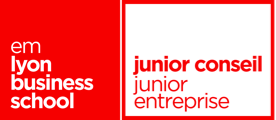

Our Services<span data-metadata="">
For the past 52 years, emlyon junior conseil has carried out over 200 studies a year, using a variety of methodologies to best meet the needs of its clients.
These studies are part of larger projects: market research, satisfaction surveys, potential studies, market intelligence, brand image surveys, fund-raising and business start-ups.
Below you’ll find details of the services we offer.
Our Services
CSR
Assessment of the company’s current impact on the environment, society and the economy

Data collection: internal policies, manager interviews, employee surveys, etc.

Formulation of CSR objectives aligned with the company’s mission and vision

Establishment of specific programs to achieve CSR objectives, such as sustainability, social justice or business ethics projects

Definition of detailed action plan
Setting indicators and standards for assessing CSR practices

Selection of leading CSR companies or organizations to be included in the benchmark

Gathering information on the CSR practices of selected companies

Comparison of the company’s performance with that of references according to defined criteria

Drafting of a report detailing the benchmark results and recommendations for improving CSR practices
Identification of legal aspects relevant to CSR, such as environmental, social and governance regulations

Selection of reliable and relevant sources, including legislative databases, official bulletins and specialized publications

Assessment of the impact of new regulations and/or legislative changes on current company practices

Presentation of a final report including relevant legislative updates and recommendations on measures to be taken to comply with CSR regulations
Assessment of the company’s current impact on the environment, society and the economy

Data collection: internal policies, manager interviews, employee surveys, etc.

Formulation of CSR objectives aligned with the company’s mission and vision

Establishment of specific programs to achieve CSR objectives, such as sustainability, social justice or business ethics projects

Definition of detailed action plan
Marketing
In-depth examination of competition, market trends and consumer behavior

Identify specific marketing objectives in line with the company’s overall goals

Divide the market into specific segments and select priority target audiences

Selection of the most appropriate communication and distribution channels, development of specific marketing tactics

Definition of a detailed action plan and allocation of the necessary budget for implementation
Clear identification of study goals to understand external expectations and perceptions

Design a targeted questionnaire to measure satisfaction levels on specific aspects of the service or product

Representative selection of participants to ensure that results are meaningful and relevant

Implementation of efficient distribution methods, data collection and statistical processing to extract trends, satisfaction levels, and identify areas for improvement

Drafting of a detailed report on results and development of an action plan to address dissatisfactions and reinforce strengths
Specification of study objectives to measure brand or company recognition among the target audience

Development of a questionnaire to assess spontaneous and assisted awareness and the quality of perceived image

Determination of selection criteria for the sample to ensure representativeness adapted to the target market, and implementation of the survey via appropriate channels

Analysis of data collected to determine brand awareness and perceptions

Compilation of results and recommendations based on awareness levels and identified opportunities for improvement in a final report
Evaluate competitors’ market positions to identify differentiation opportunities

Definition of the Unique Selling Proposition that differentiates the customer

Identify and analyze different market segments to effectively target customers

Measure of the market’s current perception of the product or service

Formulation of a clear strategy for positioning the product or service to maximize its impact and visibility on the market
Entrepreneurship / Intrapreneurship
Understanding the customer’s objectives and identifying the target audience

Development of a pitch deck structure in line with objectives and target audience

Graphic design of slides in line with the customer’s visual identity

Presentation of a first version to the customer, fine-tuning of content and presentation

Delivery of final version and presentation coaching session
Study of trends, competition and demand in the relevant market

Definition of objectives, targets and sales strategies

Creation of financial forecasts and budget scenarios

Document assembly, clear, structured writing

Critical review and finalization of the plan
Clarification of the customer’s objectives, needs and expectations

Assessment of technical solutions, technical feasibility and resources required

Analysis of economic viability, costs involved and profitability forecasts

Identification and analysis of potential risks, mitigation proposals

Drafting of the final report concluding on the feasibility of the project and recommending future actions
Review of project objectives and customer’s desired implementation criteria

Identification and evaluation of potential sites according to defined criteria

In-depth analysis of selected sites, including legal, economic and accessibility aspects

Presentation of the most viable options, with pros and cons for each site

Drafting of a detailed report offering a clear recommendation based on the complete analysis
Finance
Definition of audit scope, objectives and timetable

Analysis of financial statements and accounting records

Tests to validate the accuracy of financial information

Identify anomalies or non-compliance with accounting standards

Presentation of results to the customer and discussion of corrective measures
Gathering of financial statements, annual reports and other relevant financial documents

Assessment of the company’s ability to generate profits from its operations, using indicators such as profit margins and net income

A measure of the company’s ability to cover its short-term obligations, through ratios such as the current ratio and the quick ratio

Examination of the company’s long-term capacity to support its debts and finance its expansion, analyzed via solvency and leverage ratios

Assessment of how effectively the company uses its resources to generate revenues and control costs, using key indicators
Definition of due diligence objectives and preparation of checklist

In-depth review of the target’s financial statements and budget forecasts

Verification of legal matters, including contracts, pending litigation and compliance issues

Operational and strategic analysis and alignment with the buyer’s objectives

Drafting of a detailed due diligence report with recommendations for the transaction or adjustment of the purchase price
Determination of the funds required to start up or expand the business, including initial investments and operating costs

Identification and analysis of the various sources of financing available (bank loans, investors, subsidies, etc.)

Programming of capital contributions according to identified needs and expenditure schedule

Definition of repayment terms for borrowed financing, taking into account the company’s repayment capacity

Draw up a clear financing plan, specifying how the funds will be acquired and used over the period in question
Digital services
Understanding the customer’s vision and needs

Creation of a wireframe to validate features and design with the customer

Website development by the developers selected for the assignment

Testing to meet customer expectations and resolve potential bugs

Presentation of the website to the customer for feedback and any necessary modifications
Gathering customer requirements and objectives for the website

Analysis of current trends, competitors and best practices in the relevant field

Creation of wireframes to define the basic structure and layout of elements on the pages

Development of visual design, including selection of colors, typography and images

Presentation of the design to the customer for feedback and any necessary modifications
Understanding of the company’s mission, values and current market position

Creating a distinctive brand personality that reflects the company’s values and essence

Logo development, choice of name and key visual elements to be associated with the brand

Drafting of a brand manual detailing the use of visual elements, colors and fonts

Application of the new identity to the brand’s various media
Complete review of current website to identify technical problems, content gaps and optimization opportunities

Identify the key terms and phrases your target audience uses to search for similar products or services

Improvement of internal website elements, such as titles, metadata, and URL structure, as well as content quality assurance to match SEO best practices

Drafting of a report on the strategy put in place and the tools needed to ensure its sustainability
Define the application’s objectives, identify the target audience, and analyze the functional and technical requirements

Create wireframes and prototypes to visualize the application’s user path and interface

Application programming using appropriate languages and platforms (iOS, Android), development of backend and frontend functionalities

Carry out usability, functional and performance tests to identify and correct bugs, and ensure a smooth user experience

Deploy the application on distribution platforms (App Store, Google Play)
Field
Clarification of research questions and study objectives to guide all phases of the project

Creation of a questionnaire or other data collection tool that allows precise measurement of the variables of interest

Determining a representative sample of the target population to generalize study results

Carry out large-scale data collection by appropriate means (online, telephone, face-to-face surveys, etc.).

Use of statistical methods to analyze collected data, interpret results and test research hypotheses
Setting research objectives to guide data collection and analysis

Creation of semi-structured interview guides to provide a framework for discussions, while allowing in-depth exploration of participants’ responses

Choice of participants who bring a variety of perspectives relevant to the issues under study

Conduct interviews, generally face-to-face or via remote communication, following the guide while allowing digressions to enrich the data

Transcription of interviews, followed by detailed analysis to identify themes, motives and draw conclusions
Establishment of the specific objectives that the focus group seeks to achieve, often centered on reactions to a product, service or concept

Preparation of a discussion guide that guides the debate while encouraging interaction between participants

Formation of homogeneous groups in terms of characteristics relevant to the subject under study

Sessions led by an experienced moderator who facilitates discussion and ensures that all aspects of the guide are explored

Transcription and analysis of discussions to identify consensus, divergence and key emerging ideas
Identify the characteristics of ideal prospects to establish a precise profile

Selection of databases, professional social networks and other relevant platforms for prospect research

Extraction of contact information and relevant data from prospects matching the target profile

Set up an initial contact strategy, often by email or phone call, to establish communication and start the sales process
Definition of specific visit objectives, selection of stores to visit

Visit selected companies and evaluate them according to the objectives of the visit

Drafting of a detailed report on observations, including photos and recommendations for improving product visibility and sales.
Strategy
Specification of study objectives, such as understanding market trends, consumer needs and market size

Documentary research using the many databases available at emlyon (Xerfi, Bloomberg, etc.)

Optional field phase for more specific information

Processing and analysis of the data collected to identify trends and patterns and to answer the initial research questions

Drafting of a detailed report presenting the findings, accompanied by data visualizations and strategic recommendations
Clarification of benchmark objectives and definition of specific evaluation criteria

Identification of the main competitors to be included in the study, based on predefined criteria

Gather information on competitors from various sources, such as company reports, and databases available at emlyon (Orbis, etc.)

Examination and comparison of data collected to assess company positioning

Drafting of a detailed report presenting the results of the benchmark and proposal of an action plan based on the analyses to exploit the opportunities identified and respond to the challenges
Identification of specific monitoring objectives

Configuration of automated tools and information sources

Recurring collection of targeted data

Regular review of collected information to detect trends, opportunities and threats

Drafting of regular reports including summaries of competitors’ activities and recommendations for strategic or tactical action in response to market movements
Detailed examination of the company’s external and internal context, including the economic, social, technological, ecological and political factors that may influence its operations

Definition, in co-construction with the customer, of its vision and SMART* strategic objectives

Generation and evaluation of different potential strategies based on available resources and defined objectives

Selection of the most appropriate strategy, based on an analysis of its feasibility, risks and expected benefits

Development of a detailed action plan to implement the chosen strategy
*specific, measurable, achievable, realistic and time-defined
Human resources
Clarification of what the company wants to understand or improve through the employee satisfaction survey

Design of a questionnaire that covers all targeted aspects

Distribution of the questionnaire to employees anonymously to encourage honest and accurate responses

Evaluation of responses to identify trends, strengths and areas for improvement within the organization

Drafting of a detailed report on the results and discussion of actions to be taken with management to improve employee satisfaction
Assessment of the company’s current and future staffing needs in relation to strategic objectives and growth plans. Determining the skills, experience and qualities required for the positions to be filled.

Design of rigorous selection processes tailored to each position to ensure quality recruitment.

Implement mechanisms to measure the effectiveness of the recruitment strategy

Preparation of a final report that summarizes all activities carried out, presents the complete architecture of the proposed recruitment strategy, and includes recommendations for its implementation.
Determining customer selection criteria.

Implement a strategy for finding qualified profiles.

Analysis of CVs and setting up interviews with potential candidates.

Drafting of a recruitment report that reviews the recruitment strategy employed and the most promising profiles.

Report to customer, and contact with preferred candidates.
Contact information
Our team will be delighted to answer your questions as quickly as possible.
144 Avenue Jean Jaurès, 69007, Lyon
Monday to Friday, 8:30 a.m. to 6:30 p.m.

